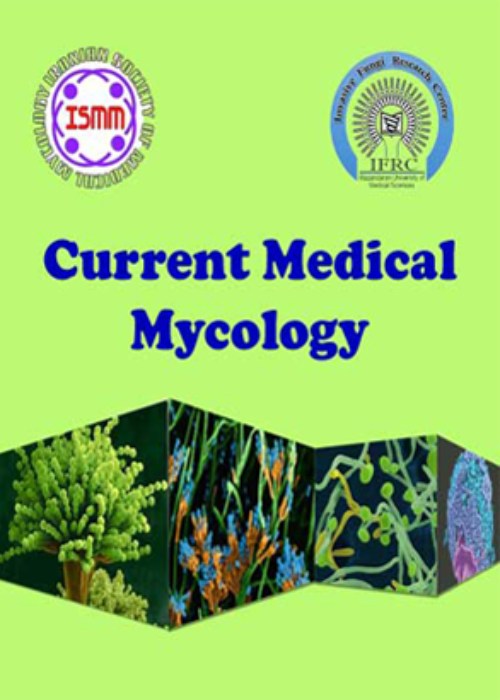Proteolytic activity and cooperative hemolytic effect of dermatophytes with different species of bacteria
Author(s):
Abstract:
Background and
Purpose
Globally, dermatophytes are the most common filamentous group of fungi causing cutaneous mycoses. Dermatophytes were shown to secrete a multitude of enzymes that play a role in their pathogenesis. There is limited data on co-hemolytic (CAMP-like) effect of different bacterial species on dermatophyte species. In this study, we sought to the evaluate exoenzyme activity and co-hemolytic effect of four bacteria on clinical dermatophytes isolated from patients in Shiraz, Iran.Materials And Methods
A total of 84 clinical dermatophyte species were isolated from patients suffering dermatophytosis and identified by conventional methods. Hemolytic activity was evaluated with Columbia 5% sheep blood agar. Proteolytic activity was determined by plate clearance assay method, using gelatin 8% agar. CAMP-like factor was evaluated with four bacteria, namely, S. areus, S. saprophyticus, S. pyogenes, and S. agalactiae. Fisher's exact test was run for statistical analysis.Results
T. mentagrophytes was the most predominant agent (27 [32.1%]) followed by T. verrucosum (20 [23.8%]), T. tonsurans (10 [11.9%]), Microsporum canis (7 [8.3%]), T. rubrum (6 [7.1%]), E. floccosum (6 [7.1%]), M. gypseum (5 [6%]), and T. violaceum (3[3.6%]). The most common clinical area of dermatophytosis was the skin. All the isolates expressed the zone of incomplete alpha hemolysis. All the isolates had CAMP- positive reaction with S. aureus and the other bacteria were CAMP-negative. All the isolates expressed proteolytic activity and no significant differences were noted among diverse genera of dermatophytes and severities of proteolytic activity.Conclusion
This study indicated that hemolysin and proteolytic enzymes potentially play a role in dermatophyte pathogenesis and S. aureus could be considered as a main bacterium for creation of co-hemolytic effect in association with dermatophyte species.Keywords:
Language:
English
Published:
Current Medical Mycology, Volume:2 Issue: 4, Dec 2016
Pages:
9 to 14
magiran.com/p1731876
دانلود و مطالعه متن این مقاله با یکی از روشهای زیر امکان پذیر است:
اشتراک شخصی
با عضویت و پرداخت آنلاین حق اشتراک یکساله به مبلغ 1,390,000ريال میتوانید 70 عنوان مطلب دانلود کنید!
اشتراک سازمانی
به کتابخانه دانشگاه یا محل کار خود پیشنهاد کنید تا اشتراک سازمانی این پایگاه را برای دسترسی نامحدود همه کاربران به متن مطالب تهیه نمایند!
توجه!
- حق عضویت دریافتی صرف حمایت از نشریات عضو و نگهداری، تکمیل و توسعه مگیران میشود.
- پرداخت حق اشتراک و دانلود مقالات اجازه بازنشر آن در سایر رسانههای چاپی و دیجیتال را به کاربر نمیدهد.
دسترسی سراسری کاربران دانشگاه پیام نور!
اعضای هیئت علمی و دانشجویان دانشگاه پیام نور در سراسر کشور، در صورت ثبت نام با ایمیل دانشگاهی، تا پایان فروردین ماه 1403 به مقالات سایت دسترسی خواهند داشت!
In order to view content subscription is required
Personal subscription
Subscribe magiran.com for 70 € euros via PayPal and download 70 articles during a year.
Organization subscription
Please contact us to subscribe your university or library for unlimited access!


